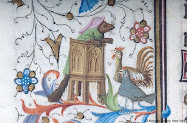Sure, I think Jones has his tongue pretty firmly in his cheek when he says,
Where Geoffrey Chaucer and his fellows had the Black Death, the Peasants’ Revolt, the Hundred Years War and the Mediaeval Warm Period, so we have Swine Flu, the G20 riots, Afghanistan and Al Gore. The names have changed, but the horsemen ain’t.
But his underlying point is sound.
 We do seem to be in another one of those periods of general crisis – endemic war, the threat of large-scale disease, social disorder and economic chaos – that so distinctively marked the later Middle Ages throughout western Europe. People who have studied those phenomena in detail in the past, analysing the ways they inter-relate to each other and to wider social, cultural, economic and political trends, have valuable insights and theoretical frameworks to offer as we grapple with the here-and-now.
We do seem to be in another one of those periods of general crisis – endemic war, the threat of large-scale disease, social disorder and economic chaos – that so distinctively marked the later Middle Ages throughout western Europe. People who have studied those phenomena in detail in the past, analysing the ways they inter-relate to each other and to wider social, cultural, economic and political trends, have valuable insights and theoretical frameworks to offer as we grapple with the here-and-now.Okay, if you start making direct one-to-one comparisons or sweeping generalisations, anyone with the most basic training in the theory and practice of professional history is going to pull you up pretty quickly. We’ll talk to you about contingency and context, and tell you that it’s not a simple case of history repeating itself (either as tragedy or as farce – sorry, Marx). But as those of us with research interests before the 17th or 18th century can attest, there is much to be gained by understanding how medieval world-views and idea(l)s about gender, sexuality, religion, political philosophy, science and medicine shaped and continue to shape the modern world.
My own research interests are clustering around the intersections between 14th century constructions of gender and conceptions of legitimately and illegitimately wielded political power. So for me, watching how constructions of gender played a significant role – both overtly and covertly – in last year’s US and New Zealand elections was fascinating. Just ask, and I’ll be happy to blab away about this for hours.
P.S. And who says we medievalists can’t get drunk and have a little kinky fun while we're buried in those archives?
P.P.S. The picture above is 'La Bête de la mer', a panel from the Apocalypse Tapestry at the Chateau d'Angers in France. The seven-headed panther-like beastie is being invested with power by the Dragon, which means the rest of us are in deep shit.




4 comments:
As an archaeologist, I get asked "what's the point" all the time.
It is hard to argue with someone who believes that the past has no influence on the present, or lessons to impart.
I'm feeling cynical today. Today's answer to "What's the point" is, "Because the State said they won't give you your building permit until we dig our holes and write about it."
I know I shouldn’t, but that comment about digging the holes made me laugh. Sometimes, it’s not worth arguing with people who just.don’t.get.it and probably never will. But it doesn’t stop me trying!
PS: The dragon picture is amazing. Deep shit, indeed!
It is, isn't it? The original panel is probably 3m x 2m big and they keep them all in a darkened room so the colours and images really pop. One of the most well-preserved tapestries I've seen from that period.
Post a Comment